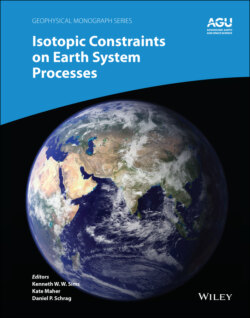Читать книгу Isotopic Constraints on Earth System Processes - Группа авторов - Страница 37
1.6. ISOTOPE FRACTIONATION BY EVAPORATION FROM SILICATE MELTS
ОглавлениеThe chemical and isotopic composition of meteorites has had a very prominent role in cosmochemistry in that it provided, among other things, the age of the solar system and the best estimate of the bulk composition of the solar system for all but the most volatile elements. Refractory calcium‐aluminum rich inclusions (CAIs), like the one shown in Fig. 1.16, are particularly important components of primitive chondritic meteorites in that they are the oldest dated materials to have formed in the solar system and, having been present at the creation, they are unique recorders of processes and conditions that prevailed in the early proto‐planetary solar nebula.
A compelling qualitative narrative has been developed regarding the origin and evolution of the Type B CAIs. Type B CAIs, or their precursors, are condensates from a cooling gas of solar composition as evidenced by their being made up of four major minerals – spinel (MgAl2O4); melilite (a solid solution between gehlenite, Ca2Al2SiO7, and åkermanite, Ca2MgSi2O7); a Ca‐pyroxene (CaMgSi2O6); and anorthite (CaAl2Si2O8) – that are predicted by thermodynamic calculations to be the early condensed minerals from a cooling solar‐composition gas (Grossman 1972). The thermodynamic calculations indicate that the materials that condensed at about 1125°C and became the precursors of the CAIs were solids. The obvious igneous texture of CAIs, like the one shown in Fig. 1.16, is evidence that at some point they must have been melted to a very high degree. In order for the Type B CAIs to have partially melted to the degree required to crystallize large euhedral melilite grains, they must have been reheated to about 1450°C (Stolper, 1982; Stolper & Paque, 1985). A very important characteristic of many CAIs is that they have distinctive oxygen, magnesium, and silicon isotopic compositions. The oxygen isotopic composition of the major minerals in CAIs fall along what appears to be a mixing line between a very 16O‐rich reservoir and a reservoir with oxygen isotopic composition close to that of Earth and other inner solar system materials. The origin of these distinct oxygen reservoirs is still the subject of heated debate and will not be considered here. The range of magnesium and silicon isotopic composition CAIs is more easily understood, in no small part by comparison to the results of laboratory evaporation experiments described in the next section.
Figure 1.16 The panel on the left shows a false color image of a Type B CAI from the Allende meteorite shown on the right. Type B CAIs are characterized by having large euhedral to sub‐euhedral crystals of melilite shown in blue. The pink grains are anorthite, the light blue grains are pyroxene, and the small red “dots” are spinel. Most of the more or less spherical inclusions in Allende are chondrules while the less abundant, typically larger and more irregular, inclusions are most likely CAIs like the one indicated by the arrow.
